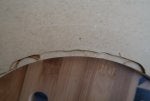Hello,
I am planning to build two subwoofer "cabinets" for my electrostatic panels. I visited a CNC shop but they specialize in volume so I decided to do it myself.
I tried cutting the curved panels with a jig saw set at 0 [disabled rotation mode] but it turns a little bit no matter how tight I hold the handle. The chaps at the CNC shop recommended that I use a portable router. I had a top of the line Craftsman router but sold it many years ago so I just purchased a new Makita RT0701CX3 1-1/4 HP Compact Router Kit that comes with a straight guide.
My question is, how do it follow the curves with my new router? I have to make four pieces that have to be identical. Please see drawing. I have also attached photos of a friend's unfinished cabinets without the grille, they were built in a shop in the UK.
Best regards,
Horacio
I am planning to build two subwoofer "cabinets" for my electrostatic panels. I visited a CNC shop but they specialize in volume so I decided to do it myself.
I tried cutting the curved panels with a jig saw set at 0 [disabled rotation mode] but it turns a little bit no matter how tight I hold the handle. The chaps at the CNC shop recommended that I use a portable router. I had a top of the line Craftsman router but sold it many years ago so I just purchased a new Makita RT0701CX3 1-1/4 HP Compact Router Kit that comes with a straight guide.
My question is, how do it follow the curves with my new router? I have to make four pieces that have to be identical. Please see drawing. I have also attached photos of a friend's unfinished cabinets without the grille, they were built in a shop in the UK.
Best regards,
Horacio
































